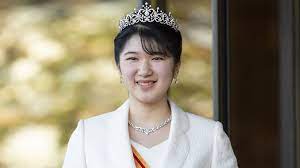She will continue to perform official duties for the imperial family, though it is unclear exactly what her new role entails.
Because only men are permitted to succeed to the throne in Japan, the 22-year-old princess is not in line for succession.
The world’s oldest surviving hereditary monarchy is found in Japan.
Princess Aiko said in a statement that she has “always had an interest” in the Red Cross, and her new employer added that they wish “to make all the necessary arrangements so that the princess can work with confidence.”
The organization has honorary presidents who are former empresses, demonstrating its close relationship to the imperial family.
Princess Aiko and her parents went to the society in October to view an exhibit about its relief efforts after the Tokyo earthquake of 1923. She has also sent her condolences to the survivors and victims of Japan’s natural disasters in recent years.
She is majoring in Japanese language and literature and is currently in her final year of study at the Faculty of Letters at Gakushuin University. The Japanese public views the princess favorably overall, and many have embraced her new role.
Mom, a “career woman,”
In Japan, Empress Masako, the mother of Princess Aiko, is regarded as a “career woman” princess and empress.
The empress, who studied at Harvard and Oxford, is a multilingual former diplomat.
She married the first in line for the Japanese throne in 1993, making history as only the second commoner to do so after the former Empress Michiko.
But after she got married, there was much conjecture about whether and when she would have a male heir.
Although Princess Aiko’s birth in 2001 was widely anticipated, the succession problem persisted.
At that point, the Japanese government started discussing whether to amend the legislation to permit women to inherit the throne.
In order to avoid a succession crisis, Emperor Naruhito’s younger brother welcomed Prince Hisahito into the world five years later.
However, it was clear that Crown Princess Masako was under pressure because she vanished from view for more than ten years.
Then-Crown Prince Naruhito made unusually harsh remarks to journalists in 2004 alleging that his wife had “completely exhausted herself” attempting to adjust to life in the palace.
The princess was subsequently declared to have a “adjustment disorder” by the palace, which is commonly interpreted as a reference to depression.







